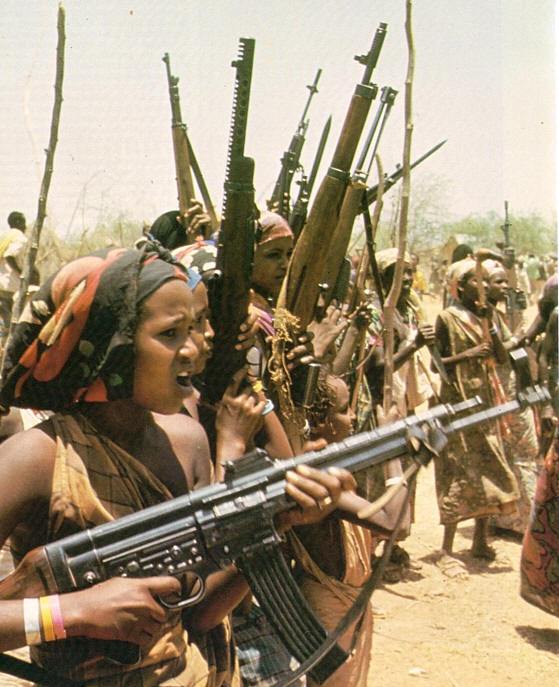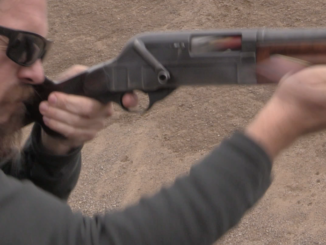Paul Mauser dedicated much of his life to the development of a practical semiauto military rifle, and did manage to have a design that was used in combat by Germany in World War One. It began with the model 06/08, a short-recoil, flap-locked design made in both rifle and pistol form. The short recoil idea was disliked by the military for a shoulder rifle, and so Mauser redesigned it to be inertially locked with a fixed barrel. This was sold in mall numbers as a sporting rifle, and tested by the military a few years before the war. Once war began, Mauser once again submitted the design for use in an infantry configuration, but the system was too delicate for infantry combat. A second pattern was made for use by fliers, and this was accepted and used in service for that brief period between the introduction of military aviation and the adoption of aerial machine guns.
Designated the FSK-16 (FliegerSelbstladeKarabiner 1916), it was used primarily by balloon and Zeppelin crews. With a large magazine and self-loading action, it was much better for use in aircraft than the typical bolt action infantry rifles – and there was no mud to get into the action while airborne.




Awesome! Please take it to the range. Ideally shoot it from a balloon or maybe an Eindecker.
That thing is built like a Rolex watch, and probably as expensive. I wonder why it didn’t catch on??
Maybe because Anthony Fokker perfected synchronized machineguns for aircraft and better chance to down an opponent with bursts?
That’s far too obvious.
Sean, the other factor in play at almost the same time as Tony F. putting the sync gear in production was the very rapid development of aero engines. Early war planes were going aloft with a mill up front that, on a good day, produced 40-50 HP. That was barely enough to lift a pilot and a load of fuel. The weight of a belt fed machine gun was more that the early engines could get into the air.
Thus, rapid fire pistols, ala the Villar Perosa, various carbines, extended mag Mauser and Springfield rifles, and this lovely gem, etc. for a VERY short time held sway. By the time these weapons were developed, trialed, production lines established and fielded in any numbers, the engine manufacturers had also been busy and were now capable of mounting 110-150 hp engines on aircraft.
More than enough to lift a Vickers, MG 08, or Hotchkiss aloft. So most of the weapons alike this Mauser beauty are relegated to “might have been” status.
The Hotchkiss was gas operated and therefore not suitable for the synchronization gears of the day. Consequently it was not used in synchronized forward firing installations. French fighters had Vickers guns just like the British ones.
On the other hand, the Lewis gun was used in many British and French fighters unsynchronized, installed on top of the upper wing and firing outside the propeller arc. This proved so popular that even some fighters with a synchronized Vickers gun still had the Lewis.
Yup!
“(…)Hotchkiss was gas operated and therefore not suitable for the synchronization gears of the day”
Was not that due to firing from open bolt rather than gas-operation?
@Daweo
Yes, I believe you are correct. Open bolt guns were more difficult to synchronize and I have actually read that as well before. I remember reading the gas-operation explanation somewhere, but I can’t remember where, and on further thinking it is clearly incorrect.
“Mauser WW1 Flyer’s Rifle: the Flieger Selbstlader Karabiner 1916”
Now I am confused, as I always though Karabiner is carbine, whilst Gewehr is rifle, so when exactly thing called in deutsch Karabiner should be named rifle in English?
If you don’t mind guesses, I would say, 1) This does appear to be shorter than the infantry rifle of the era 2) As the stock did not cover the barrel all the way to the muzzle, this would be considered a “lightened” rifle, thus a carbine 3) The air force at that time was still considered an equivalent to cavalry, a scouting arm more than a fighting force. The cavalrymen carried carbines, so thus the flying cavalry carried carbines. On top of this I would add the attitude of the German military bureaucracy, who by naming this a carbine would make sure it never found its way into the hands of ordinary ground troops.
Covering the barrel all the way to the muzzle was popular in carbines(so called bavarian stock).
The “German military bureaucracy” was more about effectiveness than class distinctions. A good example was the P.08 pistol. Handguns were for officers only in most armies, partly as a mark of rank but also due to a mistrust of the lower classes.
In the German army, once trench warfare began and it was realized that rifles were impractical for trench raiding due to length and low rate of fire, the Germans issued any handgun they could get to every soldier, with the standard Parabellum 9 x 19mm pistol being the most numerous. It fit the requirements for the kind of war they were fighting better than anything else available.
Only the U.S. and French forces issued handguns nearly as extensively as the Germans did. The French issued mostly cheap 7.65mm blowback self-loaders of the “Eibar” type, made in Spain, plus any revolvers they could acquire. One of the latter was a copy of the S&W Military & Police chambered for the 8mm French M1892 revolver round; it was nicknamed the “92 espagnole” (“92 Spanish”) by the troops.
The AEF and USMC naturally issued M1911 .45 automatics and Colt and S&W M1917 .45 revolvers to everybody. Plus shotguns, which latter alarmed the Germans quite a bit, with good reason.
One effect of this was that in a historical study one some ten years ago, it was determined that the 9 x 19mm P.08 had killed more men in combat in its existence than any other pistol. Next in line was the Colt M1911 .45, followed by the Colt Model P (1873 Single Action Army or “Peacemaker”) in its various iterations.
They are still today considered the premier “gunfighters'” handguns of all time for a very good reason. They simply have been used in, and won, more gunfights than anything else.
cheers
eon
“One effect of this was that in a historical study one some ten years ago, it was determined that the 9 x 19mm P.08 had killed more men in combat in its existence than any other pistol. Next in line was the Colt M1911 .45, followed by the Colt Model P (1873 Single Action Army or “Peacemaker”) in its various iterations” But how many were enemy? I once read a memoir by a general officer who stated that he had been present when 30 men were shot by a pistol – unfortunately, only one was an enemy. The rest were due to mishandling and playing around. When i was in the First Gulf War, it seemed like we got a couple of times a week of someone playing around who shot either himself or his buddy. Famous last words, “Watch how fast I can draw my pistol”
“(…)One effect of this was that in a historical study one some ten years ago, it was determined that the 9 x 19mm P.08 had killed more men in combat in its existence than any other pistol. Next in line was the Colt M1911 .45(…)”
But how? 9×19 Parabellum cartridge was not unique for this weapon, as it was also used Mauser C/96 variant, .45 Auto cartridge was not unique for this weapon, as it was also used in Smith & Wesson Model 1917.
This rifle’s action preceded Benelli inertial lock by decades!
With a difference that, this gun achieves the job with one way ticket whereas Benelli with two ways… It collects the energy first and transmits to the locking mechanism thereafter…
There were two version of this weapon, a rifle “gewehr” version of this weapon and and a “karabiner” version I *think* the one pictured is actually the rifle version (carbine version had a shorter vertical grip) but I may be mistaken.
The first thing I thought about looking at this was the Fedorov automatic rifle, just . Were there things developed in other countries at the same time similar to it?
https://www.tactical-life.com/firearms/air-service-m1903-rifle/
1) A well thrown brick could bring down almost all 1914 vintage airplanes
2) “Sterile environment” Compared to the trenches, yes. But Kaiser War vintage engines threw off a lot of oil – pilots complained their goggles lenses became useless from the film of oil. The Allies used castor oil in many engines – with results that can be anticipated on the aviator’s bowels. ‘Castor oil was the preferred lubricant for rotary engines, such as the Gnome engine after that engine’s widespread adoption for aviation in Europe in 1909. It was used almost universally in rotary-engined Allied aircraft in World War I. Germany had to make do with inferior ersatz oil for its rotary engines, which resulted in poor reliability” Probably didn’t do a lot of good for guns – an over lubricated gun moving at 100 mph at 10,000 feet is liable to gum up from the effect of cold on oil.
An action nearly complicated enough to be a belt fed LMG or precursor to the BAR. Fortunately for the Allies, the Central Powers seemed to be stuck on wringing the most they could out of their Maxim designs.
If you mean LMG designs, it is true that the Central Powers never developed a true LMG. Still, let’s not forget that Austria-Hungary used the Schwarzlose machine gun, which was completely unrelated to the Maxim.
S K, might it stand for Selbstlade Karabiner ?
Oddly, I have it that a German flieger, Gunther Plueschow flying a Taube managed to down a Japanese plane with a pistol… Near Tsingtao in 1914, I think. Apparently a Luger. He also escaped captivity in the UK and returned to Germany during the war
Also, some Russian pilots, pre-armament, would ram Austro-Hungarian aircraft, sacrificing their landing gear at the expense of shredding the wings of their enemies. The first guy to try it, Pyotr Nesterov, died in the ramming of an Austro-Hungarian biplane. During WWII the tactic was revived again, albeit by desperate air forces like that of the USSR during Barbarossa and Japan during the whole “floating Chrysanthemum” suicide operations…
As for German Karabiner vs. Gewehr, this gets truly murky in cases such as the G43 and/or K43 self-loading rifles in WWII. Of course, in 1935 Germany adopted the Kar98k, literally the 1898 short carbine… Which was really just a “short rifle” and not really a “true” carbine. Then again, the Spaniards used to have three-band muskets–“fusiles”–two-band muskets–“carabinas”–and for mounted troops a “tercerola.”
How long are these rifles? I only find a total length of 1150 mm on the internet but I am not sure if those are the length of the Flieger Karabiner (which I expect the most that it is) or the Infantry rifles or that maybe both are the same length.